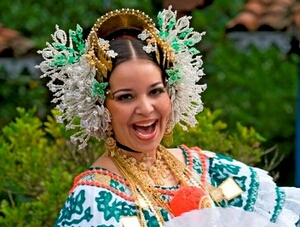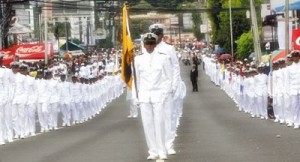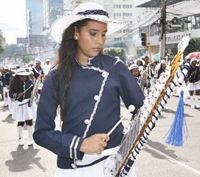While I was looking up all the holidays this month here in Panama, I came across a well laid out article by my friends at Focus Publications who put out The Visitor. November begins the season of festivities followed by Mother’s day and Christmas in December and a roll out of Summer holidays that will take us through March of next year. I hope that you are making plans now for a trip to Panama!!
Drums and trumpets, fireworks and parades – Panama’s independence takes to the streets in November with much the same party sentiment as 4th of July fireworks and a barbecue in the United States. School kids across the Isthmus have spent long hours rehearsing in their marching bands, consisting of a troop of baton spinners, a large drum-and-bugle corps and an instrument section, headed by each school’s honor role students who carry the Panamanian flag as a sign of distinction.
Civic, religious and private institutions also take part in the parades, with members dressed in folklore attire, such as the Pollera (the country’s national attire for women) and Native American and Afro-Caribbean costumes.
Many Panamanians believe theirs is a strange country, with two independence days. This, according to historians, is a bit inaccurate. To our knowledge, Panama is the only country in the world that celebrates an independence day and a secession day, which, coincidentally, are observed the same month. On November 28, the country commemorates the anniversary of its independence from Spain. Back in 1821, when a group of gentlemen met in Panama City to break ties with the Spanish crown, the country decided to become a Colombian province instead of raising a flag of its own. Eighty-two years later, on November 3, 1903, Panama seceded from Colombia and the Republic of Panama was finally born.
Although November 3rd is regarded as Panama’s National Day, Panamanians did not forget to honor the day in which they ceased to be Spanish subjects. As with other holidays observed this month (there is a long list of them) parades are the traditional way in which Isthmians observe November 28. Big parades in downtown Panama City take place on November 3 and 4, whereas only suburban communities organize parades on the 28th. Following is a list of the most important holidays in November:
November 3: Independence from Colombia
Panamanians celebrate the foundation of the Republic on November 3, when Panama separated from Colombia in 1903 with the writing of the “Acta de Independencia del Istmo”, declaring what was a province of Colombia to be an independent and sovereign nation called The Republic of Panama. The day is celebrated with a huge parade in Panama City.
November 4: Flag Day Flag Day is celebrated on November 4
The Panamanian flag was designed by Manuel E. Amador and sewn by María Ossa de Amador. They had worked on the flag when plans to become a nation were still secret.
The second day of the parade will take place in the capital city this day as well.
November 5: Independence in Colón
Independence celebrations continue on this day because it was on November 5 that Panamanian officials in Colón convinced the Colombian forces to desist their efforts to march on the Panamanian capital. Historians report that this cost them $8,000 in those days. This day finalizes the celebration of separation from Colombia and is an especially important day in Colón.
November 10: First Cry for Independence in Los Santos
In the Los Santos Province, the “Primer Grito de Independencia de Panama de España” (The First Cry for Independence from Spain) went out on this day in 1821 from leaders in La Villa de Los Santos. This region was the headquarters for the freedom movement from the Spanish Crown.
This day is a national holiday.
November 28: Independence from Spain
On this day in 1821, Panama’s independence from Spain was consolidated and the Isthmus was declared free of Spanish reign and leaders proclaimed a voluntary union with Colombia.
Celebrations in the Interior
November 6: Las Tablas
The Mil Polleras parade has been moved to Las Tablas, where Panama’s beautiful typical dress is made by hand. See Page 24 to learn more about this new tradition that is sponsored and organized by the Panama Tourism Authority (ATP).
November 10: La Villa
The events of November 10, 1821 at La Villa, province of Los Santos were powerful enough to motivate a group of Panama City gentlemen to declare independence from Spain a week later, but many aspects of how the “First Cry” actually took place remain a mystery.
“Santeños” tell you that the revolution on that day was started by Rufina Alfaro, a young, beautiful woman from the outskirts of town. The fact is that, although many parks, schools and even a Panama City district are named after her, there are no records of her existence, not even a portrait of her.
Located in the Azuero peninsula – a region considered the “Cradle of Panamanian Folklore”, the First Cry for Independence in La Villa celebration is marked by colorful parades, folklore dance performances, bullfighting (bloodless), fiddling competitions and fireworks.
La Villa is located 256 kms. southwest of Panama City, a pleasant drive by car or bus. An excellent bus service to La Villa and Chitré departs from Albrook Terminal.
November 28: Boquete
November 28 is a good day to visit Boquete to see the parade. This charming mountain town is in the foothills of the Barú Volcano, and is a popular spot for tourists and foreign retirees. Boquete is a seven hour drive from Panama City. Buses depart from the Albrook Terminal to David for services connecting to Boquete. Daily flights (one hour) depart from Marcos A. Gelabert Airport to David, where a popular “fly and drive” program with the airlines gives special rates when renting a car.


